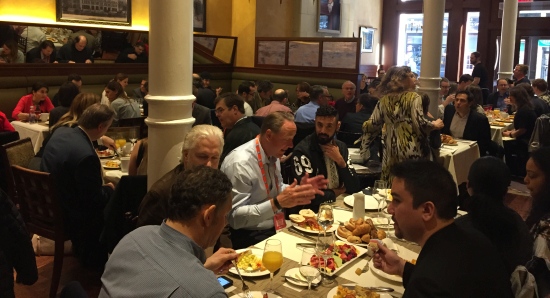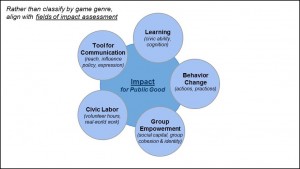 Highlights from our soft-launch of the report are below, at the 12th annual Tribeca/G4C Festival. They include:
Highlights from our soft-launch of the report are below, at the 12th annual Tribeca/G4C Festival. They include:
- a VIP breakfast to launch the report
- our panel talk
- table discussions to gather feedback
At a VIP breakfast on Day 1, we launched the report to a packed room of industry experts. In the picture below, the President of the Entertainment Software Association Michael Gallagher talks with HH Prince Fahad Al Saud of Saudi Arabia (who also presented on his game Saudi Girls Revolution). Our presentation came from team members Nicole Walden and Benjamin Stokes.
 Second, our big panel was at the Games & Media summit, at the intersection of film and games. We featured speakers who are “impact designers” from the world of documentary film, museum games and game design education. The session particularly focused on a tricky balancing act: “Optimizing for Impact AND Creativity.” Here are two pictures:
Second, our big panel was at the Games & Media summit, at the intersection of film and games. We featured speakers who are “impact designers” from the world of documentary film, museum games and game design education. The session particularly focused on a tricky balancing act: “Optimizing for Impact AND Creativity.” Here are two pictures:

(On the left: Benjamin Stokes from our advisory group, Katherine Isbister –– Game Innovation Lab at NYU Polytechnic School of Engineering, Caty Borum Chattoo — Center for Media and Social Impact (CMSi) at American University, and Colleen Macklin — PETLab at Parsons, The New School for Design.)
Panel description:
“Can we reclaim evaluation to better empower artists, our audience, and marginalized voices? What tricks of impact design can filmmakers borrow from games and vice versa? This session taps experts in ‘impact design’ who are trying new ways to maximize impact. A key focus is on shifting the hidden power relations inherent in assessment, to develop approaches that increase creativity (not stifle it). Seeking to democratize assessment and optimize it as a tool for quality rather than judgment, the panel will highlight several ambitious assessments and provide tips for teams and the field.”
We also shared pieces of our report with attendees during two practitioner lunch discussions. We received some really interesting feedback from game designers, funders and researchers — but also art historians, game distributors, and educators. Much of this feedback will end up in future reports and on our blog (we’d share a picture, but were too busy eating to take any!).
We also announced a slew of collaborators (see logos below, and list on the report page) — and more are coming! If your organization would also like to help spread the discussion of “games + impact” — including how our field is fragmented, and what can be done — let us know!


 Until mid-May, we are especially eager for ideas on what should be added to our
Until mid-May, we are especially eager for ideas on what should be added to our 

